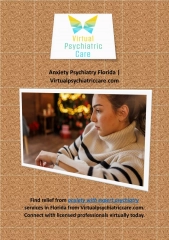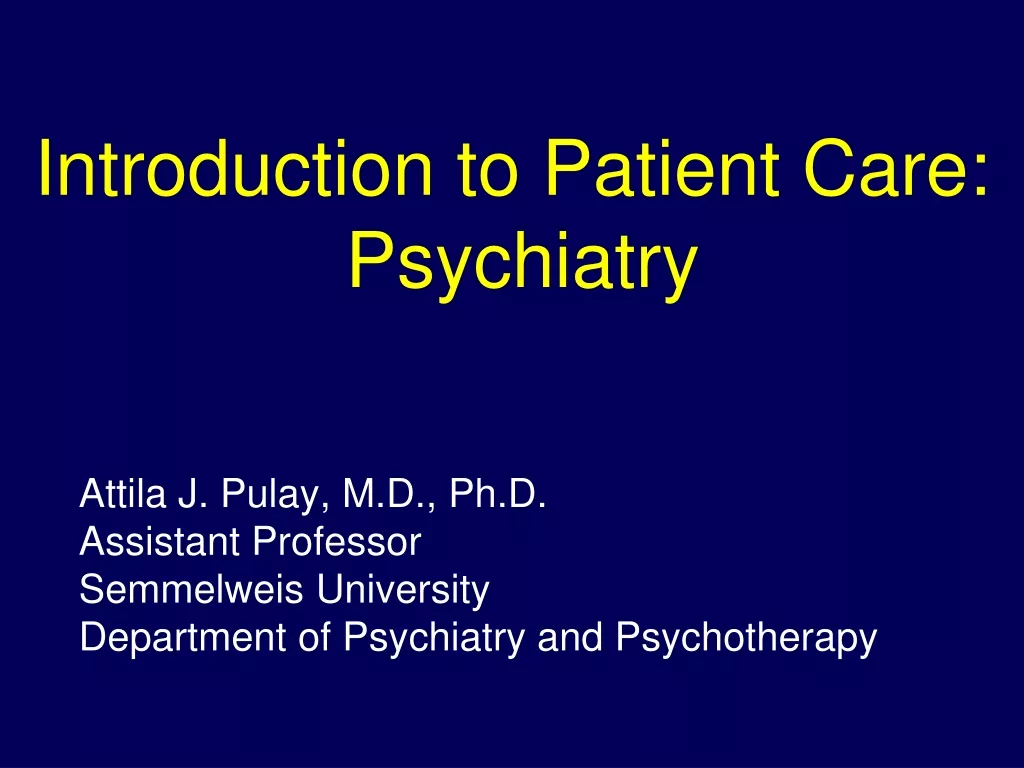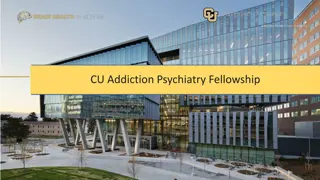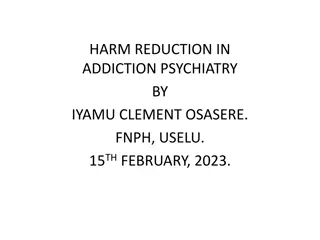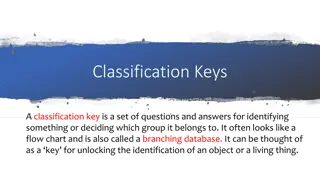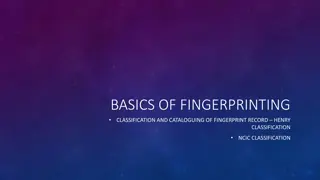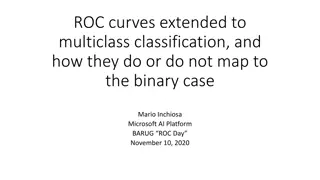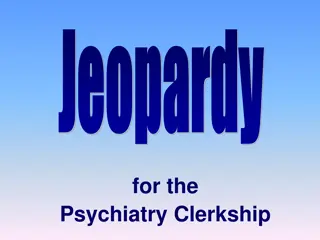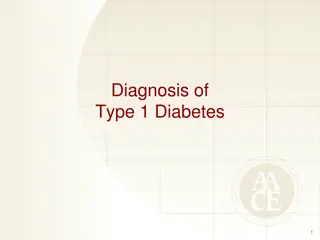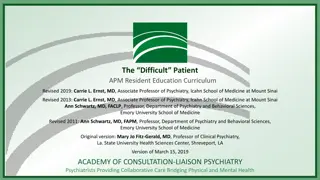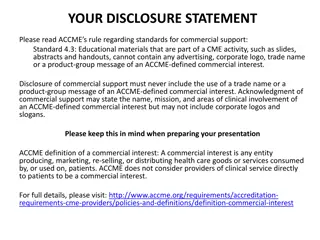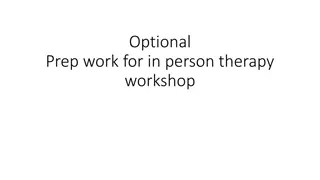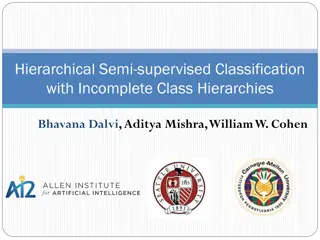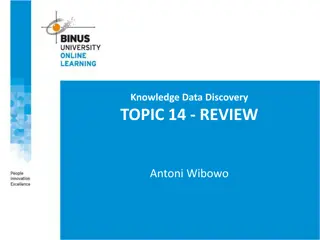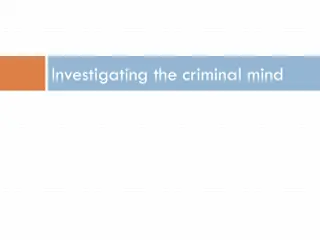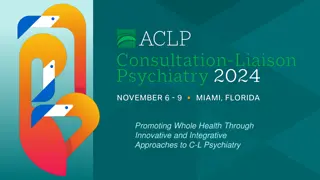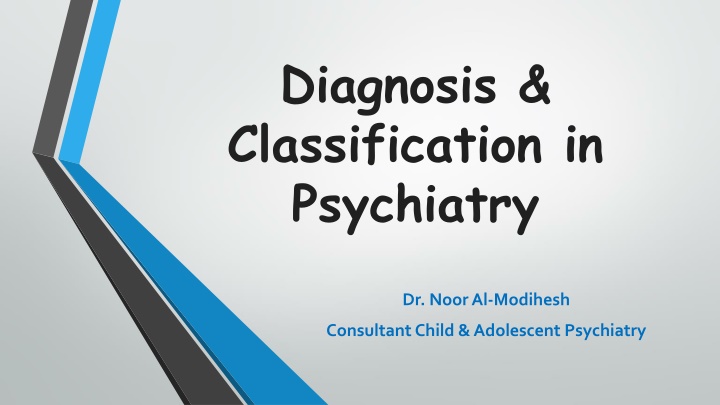
Diagnosis and Classification in Psychiatry by Dr. Noor Al-Modihesh
Explore the fundamentals of psychiatric diagnosis and classification, including distinguishing between organic and functional disorders. Gain insights into psychosis vs. neurosis, positive and negative psychotic features, and essential knowledge on psychiatric disorders, treatments, and attitudes. Develop the necessary skills and attitudes for working with psychiatric patients and families. Course materials, textbooks, and evaluation methods are provided for a comprehensive learning experience.
Download Presentation

Please find below an Image/Link to download the presentation.
The content on the website is provided AS IS for your information and personal use only. It may not be sold, licensed, or shared on other websites without obtaining consent from the author. If you encounter any issues during the download, it is possible that the publisher has removed the file from their server.
You are allowed to download the files provided on this website for personal or commercial use, subject to the condition that they are used lawfully. All files are the property of their respective owners.
The content on the website is provided AS IS for your information and personal use only. It may not be sold, licensed, or shared on other websites without obtaining consent from the author.
E N D
Presentation Transcript
Diagnosis & Classification in Psychiatry Dr. Noor Al-Modihesh Consultant Child & Adolescent Psychiatry
Objectives : -Know Basics of Diagnosis & Classification in Psychiatry. -Know the difference between organic &functional d. - Know the cues suggestive of organic mental disorders. -Know the difference between psychosis &neurosis. - Know positive & negative psychotic features.
Knowledge Psychiatric disorders : classification, etiology , course, Rx Attitude To adopt positive attitude , Negative opinion is based on unscientific public thinking, media .. Skills Psychiatric History.-Mental state Examination.- Interview Skills Eliciting Signs
Knowledge Knowledge: To acquire basic essential facts in clinical psychiatry that includes: a. Psychopathology (signs and symptoms) of psychiatric disorders. b. Classification and etiology in clinical psychiatry (bio-psycho-social). c. Common psychiatric disorders: Clinical features and course. Epidemiology and etiology. Differential diagnosis. Treatment (bio-psycho-social) and prognosis. d. Treatment modalities in psychiatry: Physical: pharmacotherapy, electroconvulsive therapy (ECT) and others. Psychological: behavioral, cognitive, supportive psychotherapy and others.
Attitude: To develop the scientific attitude towards: Psychiatric patients and their families Psychiatric interventions (bio-psycho-social) Mental health and providers (psychiatrists, psychologists, social workers and others) Psychiatry as a branch of medicine. Clinical Skills Clinical Skills: To conduct a psychiatric interview with proper interview techniques and skills for proper assessment of psychiatric problems in outpatient, inpatient, and emergency settings. Sufficient psychiatric history to enquire about various psychiatric symptoms. Standard mental state examination to elicit signs of psychiatric disorders.
Activities Activities: lectures, clinical cases/ inpatients-outpatients, video cases, others (see schedule). Course Textbook Course Textbook: Basic Psychiatry, by Mohammed. Al-Sughayir, KSU Academic Publishing & Press-2011. References: References: - Introductory Textbook of Psychiatry by Donald Black. 6th Edition. - Psychosomatic Medicine An Introduction to Consultation-Liaison Psychiatry by Amos & Robinson. Translated into Arabic by Dr. Fahad Alosaimi, KSU Academic Publishing & Press. 2014
Evaluation: Evaluation: Midterm clinical exam (4th week-Monday morning): Part A (8-9 am): Five video cases: detecting and eliciting clinical features= 20 marks. Part B (9:15- 11:45): Two short cases: see essential clinical skills in psychiatry = 20 marks. Final exam (11th week-Sunday afternoon 1-2:30): 60 MCQs/single best answer = 60 marks. Passing mark is 60. Course organizers Course organizers: : Male Students > Prof. Mohammed Alsughayir (malsughayir@ksu.edu.sa). Female students > Dr. Noor Almodihesh (nalmodihesh@ksu.edu.sa) Course secretary: Mrs. Van. 4671717
You need to review : Brain Functioning Follow the link : http://faculty.ksu.edu.sa/sughayir/Manual%20of%20Basic%20Psycchiatry/For ms/AllItems.aspx
current diagnoses are primarily syndrome based. They rely heavily on clinical observations that signs and symptoms co- occur in groups of patients and also that they have a characteristic course and response to treatment. syndromes: collections of symptoms that tend to co-occur and appear to have a characteristic course and outcome
Why do we need to diagnose symptoms of mental illness encompass a wide range of emotional, cognitive, and behavioral abnormalities == structure our mind !!. Communication between physicians Predict outcome Research
Organic Mental Disorders: psychiatric disorders characterized by neurocognitive structural brain pathology that can be detected by clinical assessment or usual tests. E.g. delirium, dementia, substance-induced mental disorders, and medication-induced mental disorders. Non-organic (functional) Mental Disorders: No obvious structural brain pathology. E.g. Schizophrenia, mood disorders, anxiety disorders, adjustment disorders.
Features Suggestive of Organic Mental Disorders (CNS pathology); Disturbed consciousness +/-other cognitive disturbance in: attention, concentration, orientation or memory. Physical illness (e.g. diabetes, hypertension). Vital signs disturbances (e.g. fever, high BP). Neurological features (e.g. ataxia, dysarthria).
Psychosis vs. Neurosis Classification: although this classification is no longer used in the official current systems of classification (DSM & ICD), in everyday clinical practice these terms are still used widely; hence it is of practical value to know this distinction.
psychosis neurosis Mental disorders in which the patient lacks insight and is unable to distinguish between subjective experience and external reality, as evidenced by disturbances in thinking (delusions), perception (hallucinations), or behavior (e.g. violence). Generally less severe forms of psychiatry disorders in which the patient is able to distinguish between subjective experience and external reality. No lack of insight, delusions or hallucinations. Examples: schizophrenia, severe mood disorders, delusional disorders. It can be due to an organic cause (organic psychosis) e.g. delirium, dementia, substance abuse, head injury. Examples: dysthymic disorder, anxiety, panic & phobic disorders. Features are abnormal in quantity (e.g. excessive fear and avoidance). Features are abnormal in quality (e.g. delusions, hallucinations).
DSM-5 Classification (May 2013) is an evidence-based manual useful in accurately and consistently diagnose mental disorders
Positive Sx Negative Sx Major disturbances in : Poverty of thoughts & speech. perception e.g. hallucination. Lack of ambition , interest & initiation. thinking e.g. delusions , FOI Restricted affect. mood e.g. extreme euphoria. Self-neglect. behavior e.g. disorganized beh. Poor self care & hygiene
The Complexity of etiology in Psychiatry 1. Time factor: causes are often remote in time from the effect they produce. 2. Single cause may lead to several psychological effects e.g. deprivation from parental affection may lead to depression or conduct disorder in children and adolescents. 3. Single effect may arise from several causes e.g. depression may be due to accumulation of several causes like endocrinopathies, psychosocial stresses and side effects of some drugs. 4. Most psychiatric disorders are multifactorial.
Effect Predisposing Precipitating Aggravating Maintaining Nature Bio E.g. Genetic predisposition e.g. panic disorder E.g. First dose of cannabis abuse E.g. Continuation of cannabis abuse E.g. Further abuse psycho- E.g. Abnormal personally traits with poor stress adaptation E.g. Sudden or severe psychological stress E.g. Further psychological stresses E.g. Continuation of such stresses social E.g. Parental separation E.g. Marital conflict E.g. continuation of marital problems Marriage
Main causative factors in psychiatry: A. Genetic : e.g. in schizophrenia , mood disorders , panic disorder and agoraphobia. B. Neuropathological: e.g. dementias ,delirium. C. Endocrinopathological: e.g. hyperthyroidism / hypothyroidism. D. Pharmacological: side effects of medications e.g. steroids > mood changes. E. Social: e.g. marital discord /occupational problems/financial difficulties. F. Psychological : behavioral ,cognitive , or psychodynamic problems (subconscious processes that
References : Manual of Basic Psychiatry , Prof.Al-Sughayir INTRODUCTORY TEXTBOOK OF Psychiatry S I X T H E D I T I O N Donald W. Black, M.D , Nancy C. Andreasen, M.D., Ph.D.

